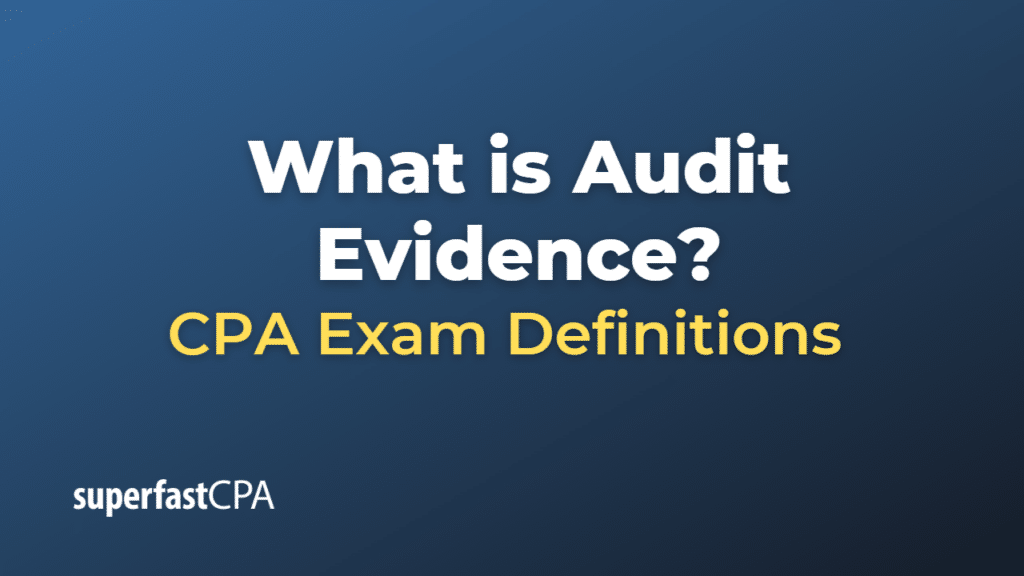Audit Evidence
Audit evidence refers to the information and documentation that an auditor collects during an audit engagement to support their conclusions, opinions, and assessments of a company’s financial statements. The purpose of audit evidence is to provide a reasonable basis for the auditor’s opinion on the financial statements’ fairness and accuracy in accordance with the applicable financial reporting framework.
Audit evidence can be gathered from various sources and can be classified into different types, such as:
- Inspection: Examining records, documents, and tangible assets to verify their existence, accuracy, and completeness. For example, inspecting invoices, contracts, and bank statements.
- Observation: Watching a process or procedure being performed by others, such as observing the client’s inventory count or internal control procedures.
- Inquiry: Asking questions and obtaining written or oral responses from the client’s management, employees, or third parties, such as vendors or customers.
- Confirmation: Obtaining direct, independent, written or electronic verification from a third party about a specific item, like confirming accounts receivable balances with customers.
- Recalculation: Checking the mathematical accuracy of documents or records, such as recalculating depreciation expenses or verifying totals in the general ledger.
- Reperformance: Independently carrying out procedures or controls that were originally performed by the client to ensure their accuracy and effectiveness.
- Analytical procedures: Evaluating financial information through analysis of plausible relationships among financial and non-financial data, such as analyzing trends, ratios, or comparing budgeted amounts with actual results.
The quality and sufficiency of audit evidence depend on its relevance and reliability. To form an appropriate audit opinion, auditors must gather sufficient, appropriate audit evidence to reduce the risk of drawing incorrect conclusions or expressing an inappropriate opinion.
Example of Audit Evidence
Let’s consider an example of an auditor collecting audit evidence during an audit engagement for a manufacturing company.
The auditor wants to verify the existence, accuracy, and completeness of the company’s inventory reported on the balance sheet. They will gather audit evidence from various sources and through different procedures:
- Inspection:
- Examining a sample of purchase orders, delivery receipts, and invoices to ensure the inventory was ordered, received, and paid for.
- Reviewing inventory records, such as the perpetual inventory system, to assess the accuracy of the recorded quantities and costs.
- Observation:
- Physically attending the company’s year-end inventory count to ensure the count is performed accurately, consistently, and according to the company’s inventory counting policies.
- Inquiry:
- Asking management about their inventory valuation methods and any potential obsolete or slow-moving inventory items.
- Discussing with warehouse personnel about their procedures for receiving, storing, and issuing inventory items.
- Confirmation:
- Sending letters or emails to a sample of suppliers to confirm the existence and terms of any consignment inventory arrangements.
- Recalculation:
- Recalculating the inventory valuation based on the company’s chosen costing method (e.g., FIFO, LIFO, or weighted average) and comparing it to the reported amounts in the financial statements.
- Reperformance:
- Selecting a sample of inventory transactions and independently tracing them through the company’s inventory system to ensure the accuracy of the recorded information.
- Analytical procedures:
- Comparing the current year’s inventory turnover ratio to prior years and industry benchmarks to identify any unusual fluctuations or trends.
- Reviewing the gross margin percentage to assess whether the inventory costs are consistent with the company’s pricing and cost structure.
By gathering sufficient, appropriate audit evidence through these procedures, the auditor can form a reasonable basis for their opinion on the inventory reported in the company’s financial statements.













